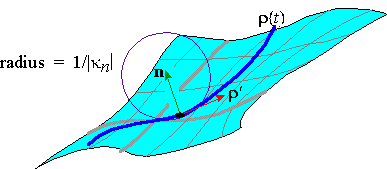Normal Curvature
Normal Curvature
In the first chapter, we developed a method for determining ' how
much a curve is ``curving'' near a point. In this section, we extend the
concept of curvature to a surface. In doing so, we will see that there are
many ways to define curvature of a surface, but only one notion of curvature
of a surface is intrinsic to the surface.
If r( t) is a geodesic of a surface, then r'' is normal to the surface, thus implying
that r'' = kN where N = ± n. It follows that r'' · n = k N · n = ±k, so that the curvature of
the geodesic is given by k = ± r'' · n. As a result, we define the normal curvature kn
in the direction of r' by
Notice that kn is positive if r'' and n point in the same direction, and is negative if r'' and n point in opposite directions. The magnitude
of kn is the curvature of the geodesic formed by the normal section
through r'.
Let's derive a formula for kn when r( u,v) is an orthogonal
parameterization of a surface and r( t) = r( u( t), v( t) ) is a geodesic
on that surface. The chain rule implies that
|
r' ( t) = ru |
du
dt
|
+rv |
dv
dt
|
|
|
It follows that the second derivative is
|
r'' = |
dru
dt
|
|
du
dt
|
+ru |
d2u
dt2
|
+ |
drv
dt
|
|
dv
dt
|
+rv |
d2v
dt2
|
|
|
so that the normal curvature is given by
|
kn = r'' · n = |
dru
dt
|
·n |
du
dt
|
+ru·n |
d2u
dt2
|
+ |
drv
dt
|
·n |
dv
dt
|
+rv·n |
d2v
dt2
|
|
|
However, ru and rv are orthogonal to n, so that
|
|
|
|
|
dru
dt
|
·n |
du
dt
|
+ |
drv
dt
|
·n |
dv
dt
|
|
| |
|
|
|
æ
è
|
ruu |
du
dt
|
+ruv |
dv
dt
|
ö
ø
|
·n |
du
dt
|
+ |
æ
è
|
ruv |
du
dt
|
+rvv |
dv
dt
|
ö
ø
|
·n |
du
dt
|
|
| |
|
| ruu·n |
æ
è
|
|
du
dt
|
ö
ø
|
2
|
+2ruv·n |
du
dt
|
|
dv
dt
|
+rvv·n |
æ
è
|
|
dv
dt
|
ö
ø
|
2
|
|
|
|
Finally, if we let du/dt = cos( q) || ru|| -1 and dv/dt = cos( q) || rv|| -1, then
|
r' = cos( q) |
ru
|| ru||
|
+sin( q) |
rv
|| rv||
|
|
|
is a unit vector at an angle q to ru.
Substituting into kn then leads to
|
kn = |
ruu·n
|| ru|| 2
|
cos2( q) +2 |
ruv·n
|| ru|| || rv||
|
cos( q) sin( q) + |
rvv·n
|| rv|| 2
|
sin2( q) |
|
Thus, the normal curvature kn( q) of the
surface in the direction q measured from ru is
|
kn( q) = |
ruu·n
|| ru|| 2
|
cos2( q) + |
ruv·n
|| ru|| || rv||
|
sin( 2q) + |
rvv·n
|| rv|| 2
|
sin2(q) |
| (1) |
We let L, M, and N denote the coefficients of cos2( q) , sin( 2q) , and sin2( q) , respectively.
EXAMPLE 1 Let r( u,v) =
á cos( u) ,sin( u) ,v
ñ be a parametrization
of the cylinder. Find the normal curvature k( q)
of the cylinder.
Solution: The partial derivatives of r( u,v)
are
|
|
|
|
á -sin( u) ,cos( u),0
ñ , rv =
á 0,0,1
ñ |
| |
|
|
á -cos( u) ,-sin( u),0
ñ , ruv = rvv =
á0,0,0
ñ |
|
|
Also, n = ru×rv =
á cos(u) ,sin( u) ,0
ñ , so that ruu·n = -cos2( u) -sin2( u) = -1 while ruv·n = rvv·n = 0. Finally, since | | ru| | = || rv| | = 1, the normal curvature is
|
|
|
|
|
ruu·n
|| ru|| 2
|
cos2( q) + |
ruv·n
|| ru|| || rv||
|
sin( 2q) + |
rvv·n
|| rv|| 2
|
sin2(q) |
| |
|
|
|
That is, if we slice the cylinder along the vector v( q) through a normal to the surface at a point P, then the curvature
at P of the curve formed by the intersection is kn (q) = -cos2(q) . To illustrate, consider that in the applet below each blue curve is a
circle with radius 1/cos2(q).
|
|
| The angle is θ = thet | °. | |
The curvature is κ n(θ) = -ax^2 |
|
|
|
Check your Reading: Is the normal curvature of the cylinder ever positive?
